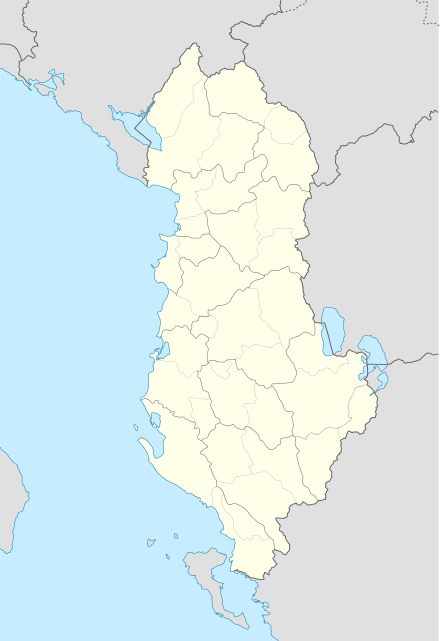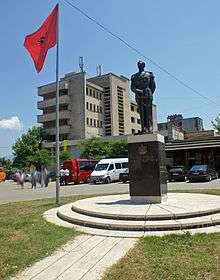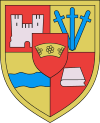Burrel, Albania
.
| Burrel, Albania | ||
|---|---|---|
| Administrative Unit | ||
 Burrel City Center | ||
| ||
 Burrel, Albania | ||
| Coordinates: 41°36′30″N 20°00′40″E / 41.60833°N 20.01111°ECoordinates: 41°36′30″N 20°00′40″E / 41.60833°N 20.01111°E | ||
| Country |
| |
| County | Dibër | |
| Municipality(s) | Mat | |
| Elevation | 316 m (1,037 ft) | |
| Time zone | UTC+1 (CET) | |
| • Summer (DST) | UTC+2 (CEST) | |
Burrel (alternate forms Burrel, Mat) is a town in northern Albania, 91 km from Tirana. At the 2015 local government reform it became a subdivision and the seat of the municipality Mat.[1] It was the seat of the former District of Mat. The population at the 2011 census was 10,862.[2]
History

The last archaeological researches has explored different trails which demonstrate the population of the area till al the paleolithic and after. The valley of Mati, has been populated during all the historic periods. The main inhabitant were the Illrian Tribe Pirustae. They resisted the Roman invasion until the second century BC.[3]
Burrel is one of the largest districts in Albania. It is also known among Albanians as the "Land of Kings", as Gjon Kastrioti, the father of Gjergj Kastrioti, better known as Skanderbeg, was born there. He was a hereditary prince of a large district of Epirus that included Mat. Another famous native of Burrel was Ahmet Zogu, first King of the Albanians (born Ahmet Zogolli, later changed to Ahmet Zogu; October 8, 1895 – April 9, 1961), who reigned as King Zog I from 1928 to 1939. He had previously been a Prime Minister of Albania between 1922 and 1924 and President of Albania between 1925 and 1928.
At one time, Burrel was referred to as the "city of apples" because of the apple trees that lined many of the town's streets, however, during the time of the Communist regime and the unrest following the change of government, the apple trees were cut down for profit or personal use as firewood. There are hardly any apple trees left in the town now.[4]
Burrel was a miners' town during Communist Albania, but the mines closed, with the exception of a ferrochrome plant still operational near Burrel.
During the Kosovo conflict there was a refugee camp near Burrel for 2,000 people. With food and water and supplies from NATO and United States Armed Forces.
Prison of Burrel
The city used to be the site of one of the most terrible prisons of the communist regime, where both ordinary criminals and political prisoners such as Bashkim Shehu and Fatos Lubonja or the Catholic priest Dom Simon Jubani were held. Another famous inmate was Pjetër Arbnori, later to become a member of the free Albanian Parliament. Arbnori was known as "the Mandela of the Balkans" because of the length of his internment, which lasted for over 28 years. It was one of the Communist Albania concentration camps. The political prisoners used to be condemned for attempts at overthrowing the state or anti-communist propaganda and agitation, for terms of at least 20 years. Often they were re-condemned while in prison. After the fall of the communist regime, the government of the Democratic Party of Albania closed the prison and made it a museum. However in 1997, Sali Berisha re-opened it as an active prison.
Archaeology
The region of Mati is a real archaeological museum and an ancient cradle of the Illyrian culture. Dilaver Kurti explored objects which demonstrate fact for all ancient historic periods, cultural development not only from the region of Mati but even for all the surroundings. It is a very important zone for the study of the Illyrian culture. The Museum of Mat is a real gem of the Illyrian culture, displaying many artifacts of the Illyrians also displayed and analyzed in the book Trashigime Iliro-Arberore by Dilaver Kurti. Kurti also traveled from village to village collecting ethnographic materials and photographs which make up the material of his books Shenime Etnografike Neper Mat and Foklor Nga Mati.[5]
Sports
Klubi Sportiv Burreli (KS Burreli) is an Albanian football (soccer) club based in Burrel. Its home stadium is Liri Ballabani Stadium, also known as the Burreli Stadium, which has a capacity of 3,000 visitors.[6] Founded in 1952 under the name "KS 31 Korriku Burrel", the club first participated in the Albanian First Division in 1982. As of the 2006-2007 season, KS Burreli is playing in the Albanian First Division.
Notable people
- Tarhoncu Ahmed Pasha - Ottoman Grand Vizier
- Ador Gjuci - footballer
- Kurt Agë Kadiu - one of the signatories of the Albanian Declaration of Independence
- Ndrek Luka - actor
- Henri Mata - footballer
- Hysni Milloshi - Communist
- Juliana Pasha - singer
- Saimir Patushi - footballer
- Zog I of Albania - king of Albania from 1928-1939
- Xhelal Bey Zogu - Albanian prince
- Xhemal Pasha Zogu - father of Zog I of Albania
- Florina Tefa - singer
- Dilaver Kurti - Archeologist, Historian 1934-1998
- Feride Kurti - Folk music singer and songwriter
See also
References
- ↑ Law nr. 115/2014
- ↑ 2011 census results Archived 2016-03-03 at the Wayback Machine.
- ↑ http://www.blue-albania.com/GeneralInfo36-Mati.htm
- ↑ Frederiksen, Martin Demant (2008). "Temporality in participation and observation: perspectives from Albania and Georgia" (pdf). Anthropology Matters. 10 (2): 4. Retrieved 19 July 2017.
- ↑ http://www.blue-albania.com/GeneralInfo36-Mati.htm
- ↑ "Liri Ballabani Stadium". CitySeeker. Archived from the original on 23 July 2017. Retrieved 23 July 2017.


